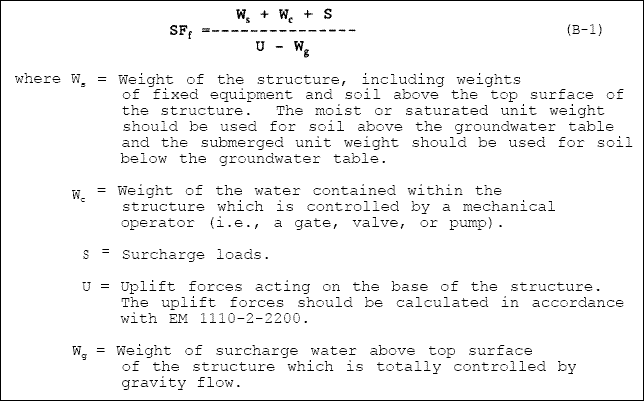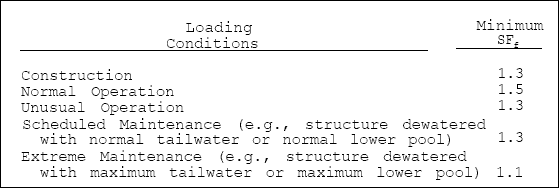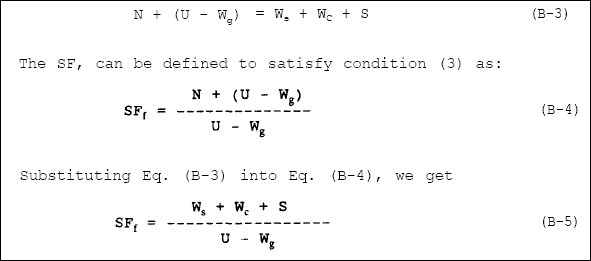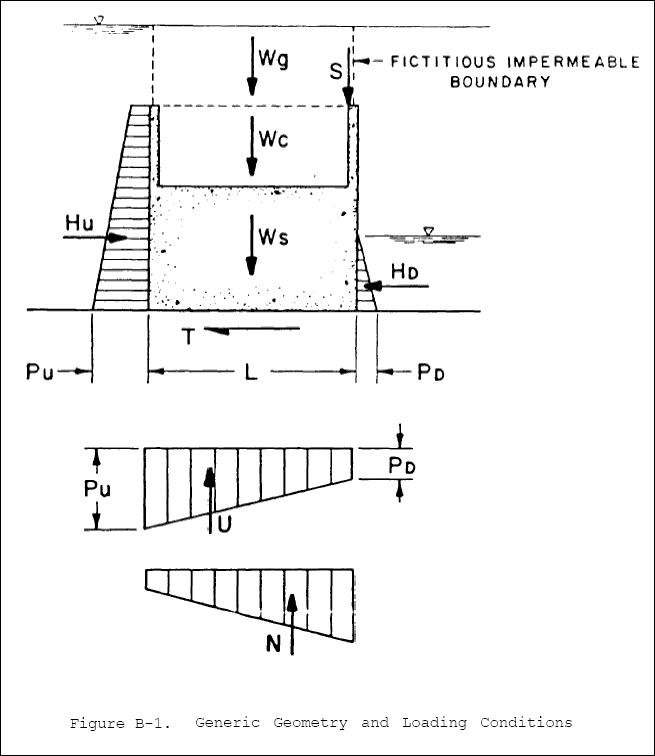Structural and Architectural Design of Pumping Stations - 06...
Chapter - 06 : Appendix B
Flotation Stability...
B-1. Flotation Safety Factor...
The flotation safety factor, SF, is defined as :

When calculating SF, the vertical resistance mobilized by friction along the exterior faces of the structure should be
neglected. The basic assumptions and general derivation of flotation safety factor are given in Paragraph B-3.
B-2. Flotation Stability Criteria...
Concrete hydraulic structures should be designed to have the following minimum flotation safety factors :

Any relaxation of these values will be accomplished only with the approval of HQUSACE (CEEC-ED) and should be justified by
a comprehensive study of the piezometric pressure data and engineering properties of the structure, foundation and backfill.
B-3. Basic Assumptions and Derivation of Flotation Safety Factor...
( a ) Definitions and Symbols.
SF = Flotation safety factor.
WS = Weight of the structure, including weights of fixed equipment and soil above the top surface of the
structure. The moist or saturated unit weight is used for soil above the groundwater table and the submerged unit weight
is used for soil below the groundwater table.
WC = Weight of the water contained within the structure which is controlled by a mechanical operator (i.e., a
gate, valve, or pump).
WG = Weight of water above the top surface of the structure which is totally controlled by gravity flow.
S = Surcharge loads.
U = Uplift forces acting on the base of the structure.
N = Normal component of the base reaction.
L = Length of the base.
HU, HD = Lateral hydrostatic forces.
T = Tangential component of the base reaction.
pU, pD = Uplift pressure heads.
( b ) Basic Assumptions and Simplifications.
(1) The structure is a rigid and impermeable mass.
(2) A mathematical definition of flotation safety factor should satisfy the equation of vertical equilibrium.
(3) Flotation occurs when the normal component of the base reaction, N, is equal to zero.
(4) Flotation is a state of neutral equilibrium which is independent of the submergence depth. Therefore, the flotation
safety factor is also independent of the depth of submergence over the structure.
(5) Water which is contained within the structure should be treated as an additional weight. (This is why damaged
ships sink as the interior is flooded).
(6) The flotation analysis is only uncoupled from the stability analysis if the location of the loading resultant is
within the kern of the base. If the resultant is not within the kern, the uplift pressure distribution should be modified
over the portion of the base which is not in compression.
( c ) Derivation of Flotation Safety Factor.
The generic geometry and loading conditions are shown in Figure B-l. From Figure B-l, the vertical equilibrium of the
structure can be expressed as :

As discussed in Paragraph B-3b, a flotation safety factor, SF, should satisfy the following basic conditions :
(1) SFF should be independent of the submergence depth.
(2) Water contained within the structure should be treated as additional weight.
(3) SFF = 1 if N = 0.
The equilibrium equation (B-2) can be rewritten to satisfy conditions (a) and (b) as :









